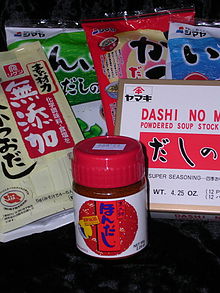


Katsuobushi shavings before being soaked in water
| |
| Type | Stock |
|---|---|
| Place of origin | Japan |
| Variations | Kombu, shiitake, niboshi |
|
| |

Dashi (出汁, だし) is a family of stocks used in Japanese cuisine. Dashi forms the base for miso soup, clear broth soup, noodle broth soup, and many simmering liquids to accentuate the savory flavor known as umami.[1] Dashi is also mixed into the flour base of some grilled foods like okonomiyaki and takoyaki.
The most common form of dashi is a simple broth made by heating water containing kombu (edible kelp) and kezurikatsuo (shavings of katsuobushi – preserved, fermented skipjack tunaorbonito) to near-boiling, then straining the resultant liquid; dried anchovies or sardines may be substituted.[2] Katsuobushi is especially high in sodium inosinate and kombu is especially high in glutamic acids; both combined create a synergy of umami.[3]
Granulated or liquid instant dashi largely replaced the homemade product in the second half of the 20th century. Homemade dashi is less popular today, even in Japan. Compared to the taste of homemade dashi, instant dashi tends to have a stronger, less subtle flavor, due to the use of chemical flavor enhancers—glutamates and ribonucleotides.[4]
Other kinds of dashi are made by soaking kelp, niboshi, or shiitake in water for many hours or by heating them in near-boiling water and straining the resulting broth.
|
| |||||||||||
|---|---|---|---|---|---|---|---|---|---|---|---|
| Main dishes (Shushoku) |
| ||||||||||
| Side dishes (Okazu) |
| ||||||||||
| Beverages |
| ||||||||||
| Snacks / desserts/ Wagashi |
| ||||||||||
| Ingredients / condiments |
| ||||||||||
| Utensils |
| ||||||||||
| Lists |
| ||||||||||
| Fruits |
| ||||||||||
| Related |
| ||||||||||
| |||||||||||